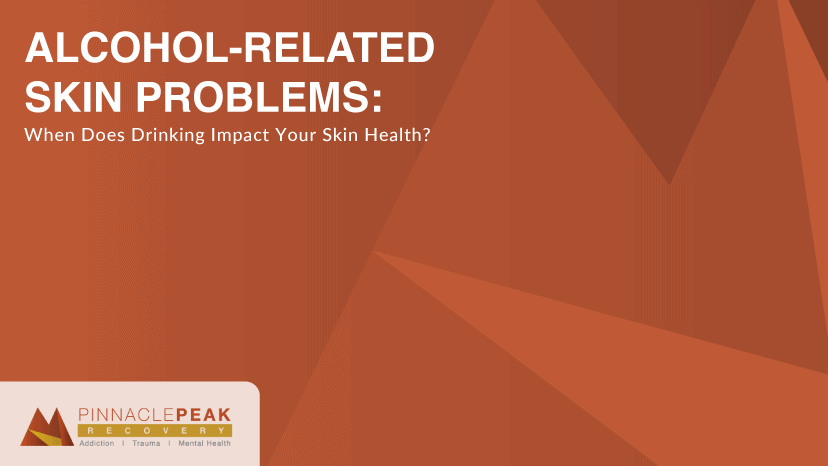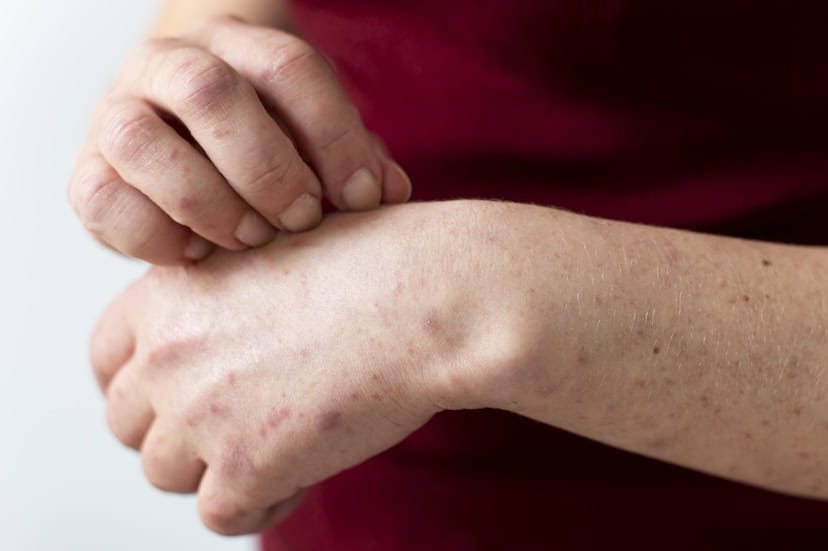In 2023, over $21 billion was spent on skin care across the United States. A combination of trends and an increase in knowledge about health has widely contributed to this. Did you know, however, that alcohol use can directly impact your skin health?
Here in Arizona, approximately 1 in 6 people binge drink at least once a month. How can this impact your skin health? Our team here at Pinnacle Peak Recovery has years of experience in the field of substance use. We want to help provide information about substance use and alcohol use so you can make informed decisions about your health. Today we’re going to talk about alcohol-related skin problems, how to spot them, and how to manage them.
What Are the Ways That Alcohol Can Affect Your Skin?
The appearance and health of our skin is often a direct result of our diet, lifestyle, and overall health. When you’re stressed you might break out in acne. If you ate some extra greasy food, your face might become a little more oily. The same cause and effect holds true with alcohol in many ways.
No matter your level of alcohol use, drinking it can impact your skin – from temporary side effects to long-term damage. The exact effects range depending on your history with alcohol, the state of your liver, your overall health, diet, and more.
Let’s take a closer look at how different types of alcohol consumption can affect the skin.
How One Night Out Can Impact Your Skin Health
Even if you don’t drink regularly, or you only drink in social situations, alcohol can cause your skin to weaken. The biggest way it does this is through dehydration. Alcohol dehydrates us, and hydration is pivotal to the appearance and health of our skin.
Water in the body helps not only with circulation, digestion, and the ridding of toxins but for the skin specifically, it helps contribute to its strength and elasticity. All of these combined can slowly chip away at our skin health if we’re regularly dehydrated. This can lead to paler skin and an increased chance of developing lines and wrinkles.
Beyond dehydration, though, there are more ways that even one night out can impact our skin.
Flushed and Puffy Face From Alcohol Use
You might’ve heard of people who get red in the face when they drink. Maybe you’ve seen a friend who has this happen, or maybe it happens to you. Either way, this isn’t just a chance reaction – people who flush when drinking have an alcohol intolerance.
An alcohol intolerance is not interchangeable with an alcohol allergy. Those who are intolerant do not metabolize alcohol as effectively as those who aren’t intolerant. This can occur due to genetics or because of certain medications.
The only way to avoid the unpleasant side effects of alcohol intolerance is to reduce how much you drink. Those who continue to drink have an increased risk of developing certain types of cancer such as breast cancer or esophageal cancer.
Alcohol-Related Dark Circles
Our quality of sleep has a big effect on our skin. Both oversleeping and undersleeping can make your skin become duller or paler. This leads to your blood vessels and other tissues under your skin to become more visible.
These changes are one of the common causes of dark circles. Alcohol consumption, especially in larger quantities, can greatly alter your normal sleeping patterns, contributing to the appearance of dark circles.
Skin Conditions That Develop With Long-Term Alcohol Use
Long-term and heavy alcohol use contributes to a wide range of conditions, some of which specifically impact the skin. While the health of our body overall is reflected in the skin, these conditions have a greater impact than others.
Seborrheic Dermatitis
This condition is a chronic form of eczema, primarily appearing in parts of the body that have a high oil production. This commonly includes the upper back, nose, and scalp. Seborrheic dermatitis can develop at any age and is a reaction to excess yeast in the body.
Seborrheic dermatitis causes dandruff, redness, swelling, and excess oil production.
Nummular Dermatitis
Nummular dermatitis, also known as discoid eczema, often appears like psoriasis, ringworm, or a fungal infection. It causes circular, itchy, and oozing patches on the skin that are often the size of a coin.
This condition results from poor blood flow or already having other forms of eczema, both of which can stem from a history of alcohol use.
Increased Risk of Skin Infections and Sun Sensitivity
At the end of the day, alcohol is a toxin. It is not healthy for our bodies and over time it can leave a lasting, negative impact.
Just like alcohol can kill brain cells, it can also lower the production of important antioxidants and weaken our immune system. This leaves you at an increased risk of infections in any part of the body, and also an increased risk of sunburn.
The Ways That Skin Can Change Due to Alcohol-Related Liver Damage
The liver is the primary processing center for alcohol as it passes through the body. Because alcohol is toxic, the more often the liver has to process it, the more likely that it will become damaged.
Unfortunately, many forms of liver damage from alcohol use aren’t detectable until they’re far along. One of the ways you can be mindful of potential damage is to look for the signs in your skin.
Here are the most common signs of liver damage that can appear on the skin:
- Pruritus – People with a chronic liver disease often experience this symptom, otherwise known as itching. It can occur on any part of the body. It’s not always visual, but can also occur alongside reddened or bumpy skin.
- Jaundice – When your liver is damaged, it prevents the removal of bilirubin, which forms from the breakdown of red blood cells. This is normally excreted through the urine, but when it’s not excreted it can build up in the bloodstream. This leads to a yellow discoloration of the skin and eyes, sometimes accompanied by itching.
- Xerosis – When your liver is unable to properly metabolize vitamin A, you can develop xerosis, otherwise known as dry skin.
- Spider angioma – These lesions that form on the skin normally stem from a red spot with blood vessels extending out from it, giving the appearance of a spider. These lesions are often painless but can be a sign of cirrhosis, or extreme liver damage.
The Link Between Alcohol Consumption and Skin Cancer
Alcohol is a carcinogen, which is something that has been medically determined to be a leading cause of cancer. Alcohol specifically is a carcinogen because of how it damages cells and DNA within the body. This can lead to an increased risk of a variety of cancers, including skin cancer.
The Treatment Options Available for Alcohol Use and Skin Damage in Arizona
If this article sounds familiar to you and you wish to do something about it, the only way to truly address alcohol-related skin issues is to stop drinking. After alcohol treatment, you can start to heal and recover from the damage done to your skin.
Everyone deserves to have access to help when they want it. You deserve to have support that understands you and wants to help you find care that will work for your needs. From detox programming to effective, evidence-based inpatient and outpatient services, there are options available for you.
This is where Pinnacle Peak comes into play. Our team will work to help craft a plan that suits your unique needs. With our full continuum of care available, you’ll get the support you need, when you need it. Give us a call anytime at 866-377-4761 to learn more or get started today.
Clinical Excellence | Compassionate Care | Family Feel
FAQs About Alcohol-Related Skin Problems
What does an alcohol rash look like?
An alcohol-related rash will look much like any other allergic reaction rash. It appears as small, red bumps across the skin. It can also appear as primarily a deep, red flush. In addition to a rash, someone allergic to alcohol might also experience a runny nose, lowered blood pressure, worsening asthma, and itchiness.
Can skin damage from drinking be reversed?
There are many conditions caused by drinking that can be addressed through proper treatment and care. The most important thing you can do to address these concerns is to stop drinking. From there, seeking medical help about the specific conditions can give you better insight into how to address them and what timeline it might take to see progress. Not all conditions can be addressed overnight.



